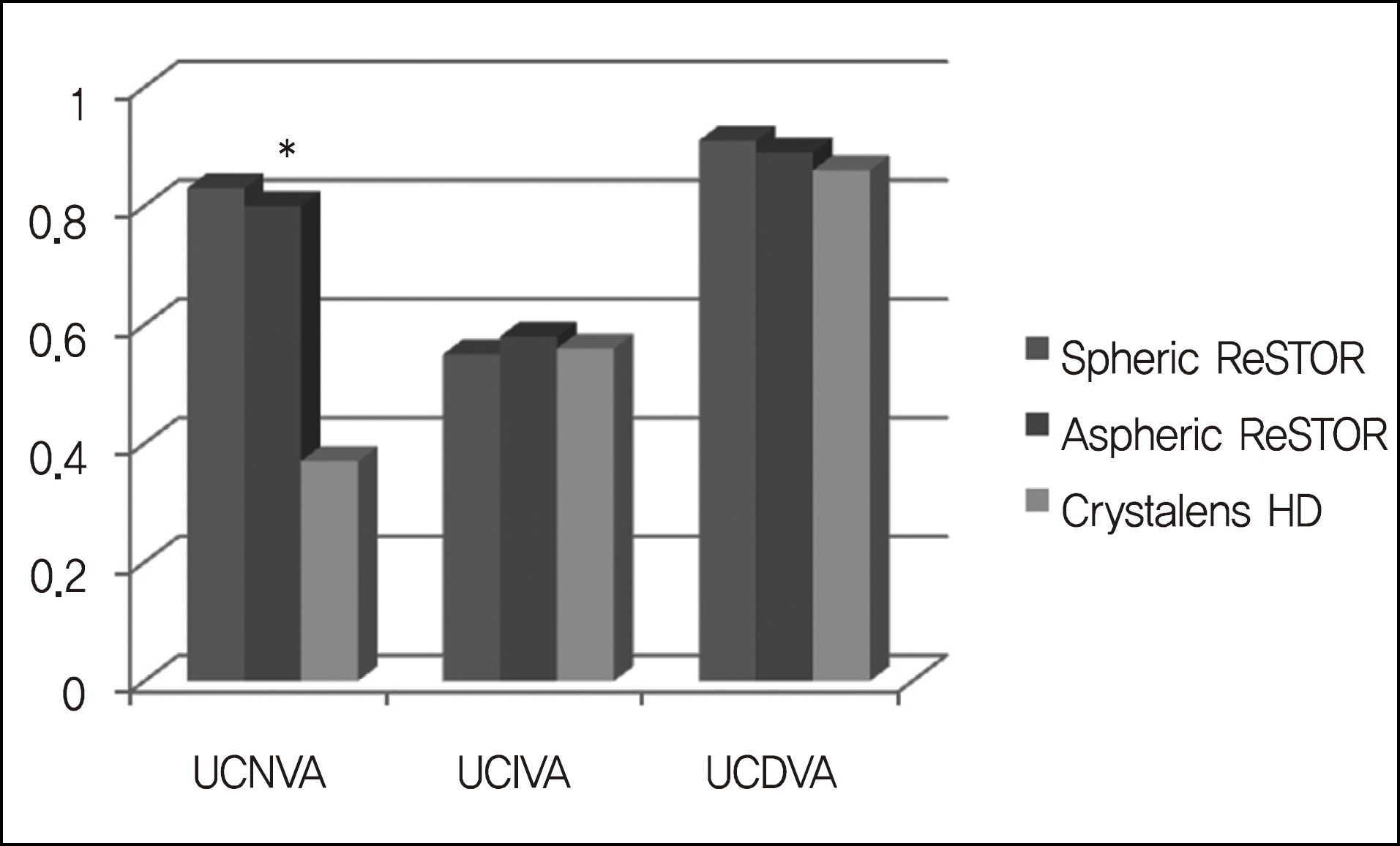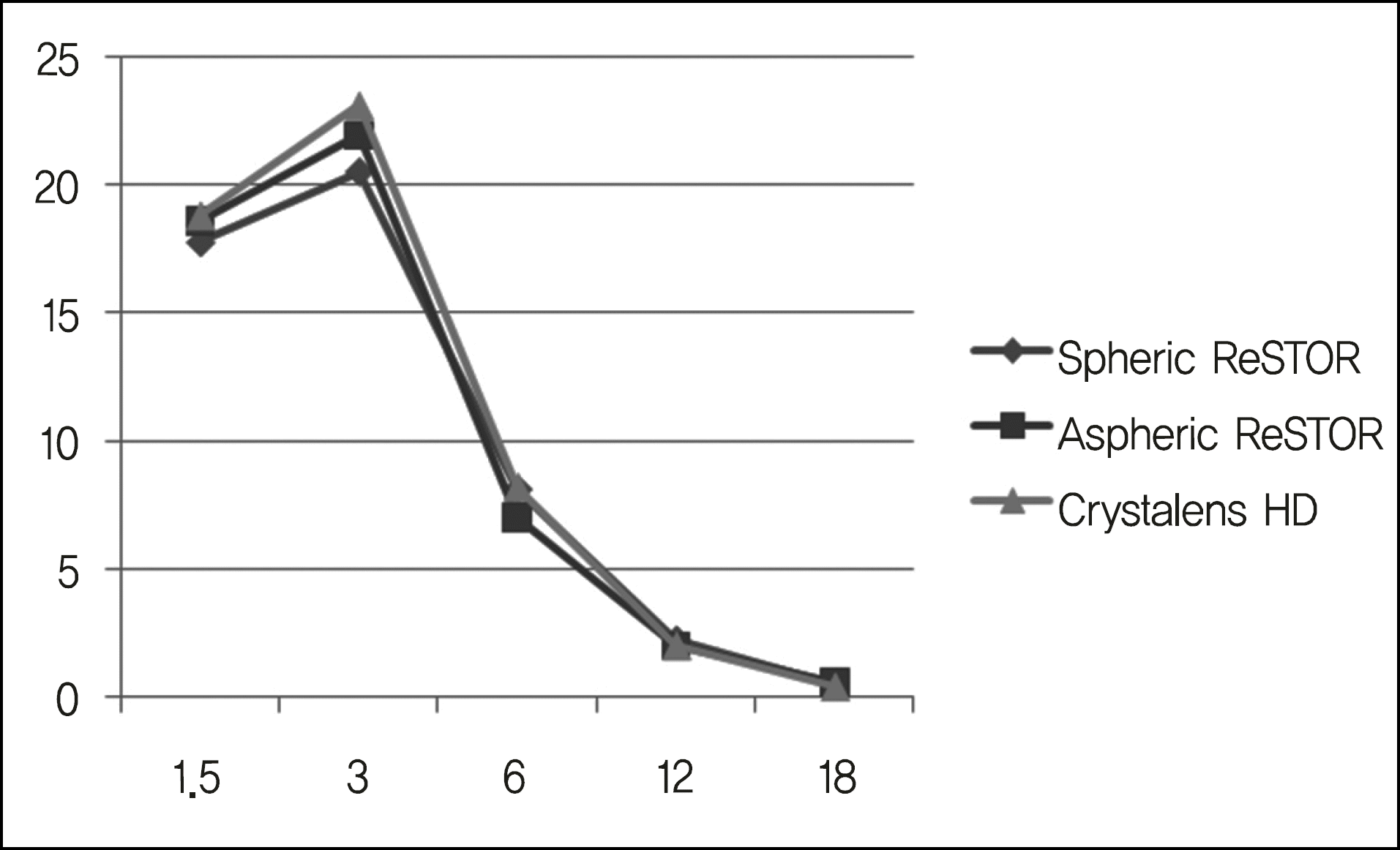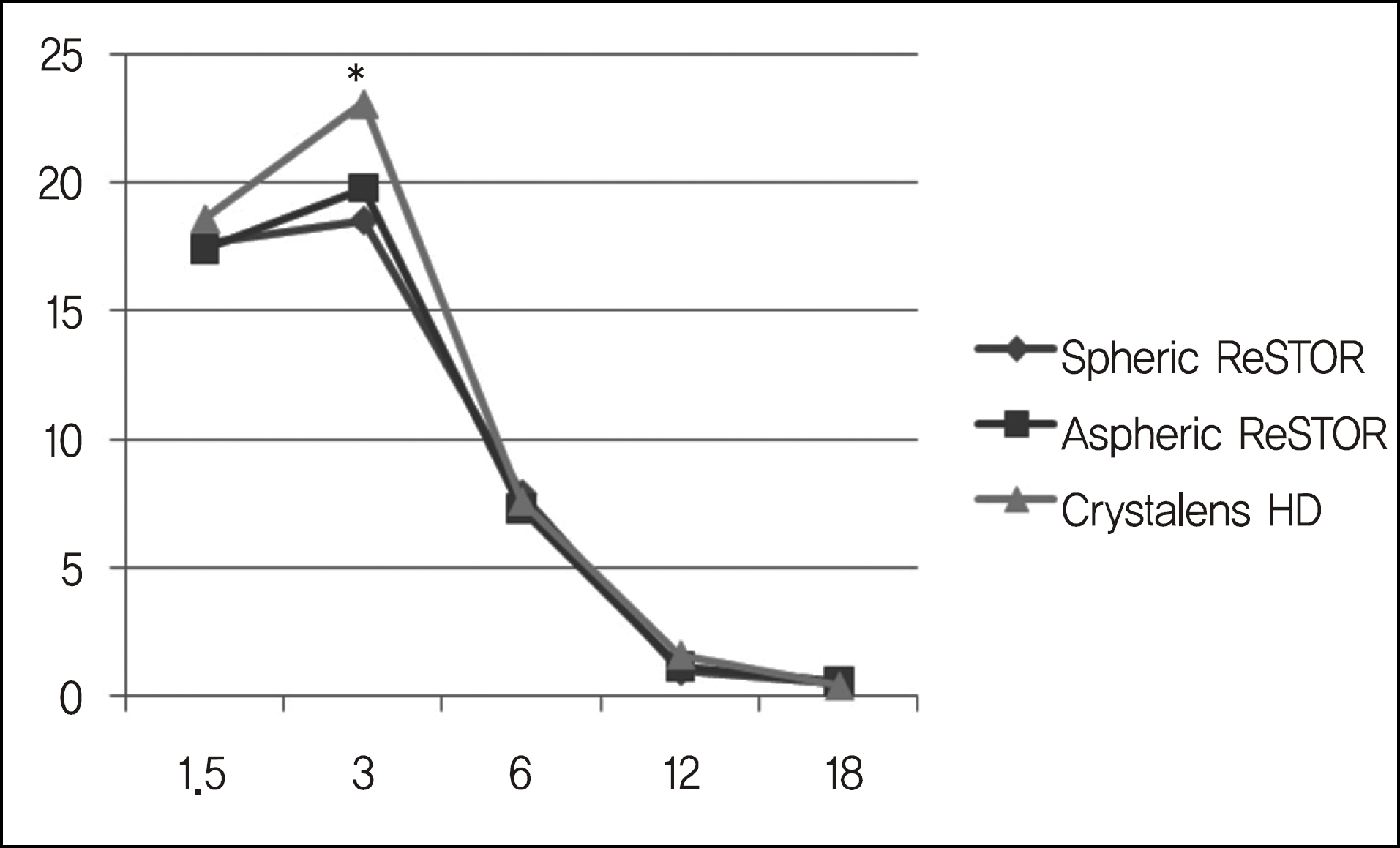Abstract
Purpose
To assess visual acuity, spherical aberration and contrast sensitivity in patients who were implanted with spheric, aspheric ReSTOR® or Crystalens HD® lenses.
Methods
The present study enrolled 16 patients (32 eyes) implanted with biliateral spheric ReSTOR® (four patients, spheric ReSTOR group), bilateral aspheric ReSTOR® (seven patients, aspheric ReSTOR group) or bilateral Crystalens HD® (five patients, Crystalens HD group) lenses. At three months postoperatively, visual acuity, spherical aberration, and contrast sensitivity were evaluated.
Results
Three months after surgery, there were no significant differences in uncorrected distant or intermediate visual acuity among the three groups. Uncorrected near visual acuity in the spheric and aspheric ReSTOR groups was superior to that in the Crystalens HD group, and the aspheric ReSTOR group had less spherical aberration. Mesopic contrast sensitivity in the Crystalens HD group was significantly higher at three cycles per degree compared to those in the spheric and aspheric ReSTOR groups.
References
1. Lane SS, Morris M, Nordan L, et al. Multifocal intraocular lenses. Ophthalmol Clin North Am. 2006; 19:89–105.
2. Hütz WW, Eckhardt HB, Röhrig B, Grolmus R. Reading ability with 3 multifocal intraocular lens models. J Cataract Refract Surg. 2006; 32:2015–21.

3. Kohnen T, Allen D, Boureau C, et al. European multicenter study of the AcrySof ReSTOR apodized diffractive intraocular lens. Ophthalmology. 2006; 113:584.e1.

4. Blaylock JF, Si Z, Vickers C. Visual and refractive status at different focal distances after implantation of the ReSTOR multifocal intraocular lens. J Cataract Refract Surg. 2006; 32:1464–73.

5. Chiam PJ, Chan JH, Aggarwal RK, Kasaby S. ReSTOR intraocular lens implantation in cataract surgery: quality of vision. J Cataract Refract Surg. 2006; 32:1459–63.

6. Sallet G. Refractive outcome after bilateral implantation of an apodized diffractive intraocular lens. Bull Soc Belge Ophtalmol. 2006; 299:67–73.
7. Souza CE, Muccioli C, Soriano ES, et al. Visual performance of AcrySof ReSTOR apodized diffractive IOL: a prospective comparative trial. Am J Ophthalmol. 2006; 141:827–32.

8. Cumming JS, Colvard DM, Dell SJ, et al. Clinical evaluation of the Crystalens AT-45 accommodating intraocular lens: results of the U.S. Food and Drug Administration clinical trial. J Cataract Refract Surg. 2006; 32:812–25.
9. Barbero S, Marcos S, Jiménez-Alfaro I. Optical aberrations of intraocular lenses measured in vivo and in vitro. J Opt Soc Am A Opt Image Sci Vis. 2003; 20:1841–51.

10. Yun JH, Ahn K, Lee DH, et al. Spheric, aspheric ReSTOR intraocular lens: three-month results and preoperative clinical factors influencing patient's satisfaction. J Korean Ophthalmol Soc. 2010; 51:14–21.

11. Pepose JS, Qazi MA, Davies J, et al. Visual performance of patients with bilateral vs combination Crystalens, ReZoom, and ReSTOR intraocular lens implants. Am J Ophthalmol. 2007; 144:347–57.

12. Stachs O, Schneider H, Beck R, Guthoff R. Pharmacological-induced haptic changes and the accommodative performance in patients with the AT-45 accommodative IOL. J Refract Surg. 2006; 22:145–50.

13. Lee HS, Park SH, Kim MS, et al. Clinical results and some problems of multifocal apodized diffractive intraocular lens implantation. J Korean Ophthalmol Soc. 2008; 49:1235–41.

14. Sen HN, Sarikkola AU, Uusitalo RJ, Laatikainen L. Quality of vision after AMO Array multifocal intraocular lens implantation. J Cataract Refract Surg. 2004; 30:2483–93.

15. Steinert RF, Post CT Jr, Brint SF, et al. A prospective, randomized, double-masked comparison of a zonal-progressive multifocal intraocular lens and a monofocal intraocular lens. Ophthalmology. 1992; 99:853–60.

16. Percival SP, Setty SS. Prospectively randomized trial comparing the pseudoaccommodation of the AMO Array multifocal lens and a monofocal lens. J Cataract Refract Surg. 1993; 19:26–31.

17. Jacobi PC, Konen W. Effect of age and astigmatism on the AMO Array multifocal intraocular lens. J Cataract Refract Surg. 1995; 21:556–61.

18. Javitt JC, Wang F, Trentacost DJ, et al. Outcomes of cataract extraction with multifocal intraocular lens implantation: functional status and quality of life. Ophthalmology. 1997; 104:589–99.
19. Javitt JC, Steinert RF. Cataract extraction with multifocal intraocular lens implantation: a multinational clinical trial evaluating clinical, functional, and quality-of-life outcomes. Ophthalmology. 2000; 107:2040–8.
Figure 1.
Mean postoperative uncorrected visual acuities of the 3 groups. There was significant difference in the uncorrected near visual acuity (UCNVA) (p < 0.001, ANOVA test). * UCNVA = uncorrected near visual acuity; UCIVA = uncorrected intermediate visual acuity; UCDVA = uncorrected distant visual acuity. Statistically significant in ANOVA (p < 0.05).

Table 1.
Baseline characterisctics of participants
| | Spheric ReSTOR | Aspheric ReSTOR | Crystalens HD |
|---|---|---|---|
| No. of patients | 4 | 7 | 5 |
| No. of eyes (OD/OS) | 8 (4/4) | 14 (7/7) | 10 (5/5) |
| Gender (M/F) | 2/2 | 3/4 | 2/3 |
| Mean ± SD (age) | 61.13 ± 2.10 | 64.38 ± 2.32 | 63.42 ± 2.25 |
Table 2.
Postoperative aberrations (μ m) measured by iTrace aberrometer among 3 groups (mean ± standard deviation)
| | RMS* total | RMS HOA† | SA‡ (Ocular) | SA (Internal) | SA (Cornea) | Coma 7 A | Coma 8 A | Trefoil 6 A | Trefoil 9 A |
|---|---|---|---|---|---|---|---|---|---|
| Spheric ReSTOR | 1.149 ± 0.452 | 0.677 ± 0.439 | 0.245 ± 0.229 | −0.005 ± 0.172 | 0.250 ± 0.086 | 0.173 ± 0.197 | −0.107 ± 0.153 | −0.120 ± 0.102 | 0.135 ± 0.225 |
| Aspheric ReSTOR | 0.675 ± 0.267 | 0.624 ± 0.444 | 0.040 ± 0.141 | −0.155 ± 0.194 | 0.202 ± 0.112 | 0.305 ± 0.276 | −0.035 ± 0.113 | −0.022 ± 0.185 | 0.098 ± 0.148 |
| Crystalens HD | 1.021 ± 0.353 | 0.359 ± 0.342 | 0.215 ± 0.234 | −0.025 ± 0.233 | 0.233 ± 0.074 | 0.349 ± 0.376 | −0.076 ± 0.206 | 0.021 ± 0.166 | 0.060 ± 0.217 |
| p-value | 0.008 | 0.208 | 0.041 | 0.292 | 0.385 | 0.445 | 0.573 | 0.196 | 0.709 |




 PDF
PDF ePub
ePub Citation
Citation Print
Print




 XML Download
XML Download